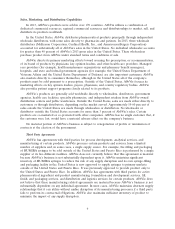AbbVie 2013 Annual Report Download - page 20
Download and view the complete annual report
Please find page 20 of the 2013 AbbVie annual report below. You can navigate through the pages in the report by either clicking on the pages listed below, or by using the keyword search tool below to find specific information within the annual report.New products and technological advances by AbbVie’s competitors may negatively affect AbbVie’s results of
operations.
AbbVie competes with other research-based pharmaceuticals and biotechnology companies that
discover, manufacture, market, and sell proprietary pharmaceutical products and biologics. For
example, HUMIRA competes with a number of anti-TNF products that are approved for a number of
disease states and AbbVie’s virology products compete with protease inhibitors and other anti-HIV
treatments. These competitors may introduce new products or develop technological advances that
compete with AbbVie’s products in therapeutic areas such as immunology, virology, renal disease,
dyslipidemia, and neuroscience. AbbVie cannot predict with certainty the timing or impact of the
introduction by competitors of new products or technological advances. Such competing products may
be safer, more effective, more effectively marketed or sold, or have lower prices or superior
performance features than AbbVie’s products, and this could negatively impact AbbVie’s business and
results of operations.
AbbVie’s biologic products may become subject to competition from biosimilars.
The Biologics Price Competition and Innovation Act was passed on March 23, 2010 as Title VII to
the Patient Protection and Affordable Care Act. The law created a framework for the approval of
biosimilars in the United States and could allow competitors to reference data from biologic products
already approved. In Europe, the European Commission has granted marketing authorizations for
several biosimilars pursuant to a set of general and product class-specific guidelines for biosimilar
approvals issued over the past few years. In addition, companies are developing biosimilars in other
countries that could compete with AbbVie’s biologic products. If competitors are able to obtain
marketing approval for biosimilars referencing AbbVie’s biologic products, AbbVie’s products may
become subject to competition from such biosimilars, with the attendant competitive pressure and
consequences. Expiration or successful challenge of AbbVie’s applicable patent rights could also trigger
competition from other products, assuming any relevant exclusivity period has expired. As a result,
AbbVie could face more litigation with respect to the validity and/or scope of patents relating to its
biologic products.
The manufacture of many of AbbVie’s products is a highly exacting and complex process, and if AbbVie or
one of its suppliers encounters problems manufacturing AbbVie’s products, AbbVie’s business could suffer.
The manufacture of many of AbbVie’s products is a highly exacting and complex process, due in
part to strict regulatory requirements. Problems may arise during manufacturing for a variety of
reasons, including equipment malfunction, failure to follow specific protocols and procedures, problems
with raw materials, delays related to the construction of new facilities or the expansion of existing
facilities, including those intended to support future demand for AbbVie’s products, changes in
manufacturing production sites and limits to manufacturing capacity due to regulatory requirements,
changes in the types of products produced, physical limitations that could inhibit continuous supply,
man-made or natural disasters, and environmental factors. If problems arise during the production of a
batch of product, that batch of product may have to be discarded and AbbVie may experience product
shortages or incur added expenses. This could, among other things, lead to increased costs, lost
revenue, damage to customer relations, time and expense spent investigating the cause and, depending
on the cause, similar losses with respect to other batches or products. If problems are not discovered
before the product is released to the market, recall and product liability costs may also be incurred.
16
























